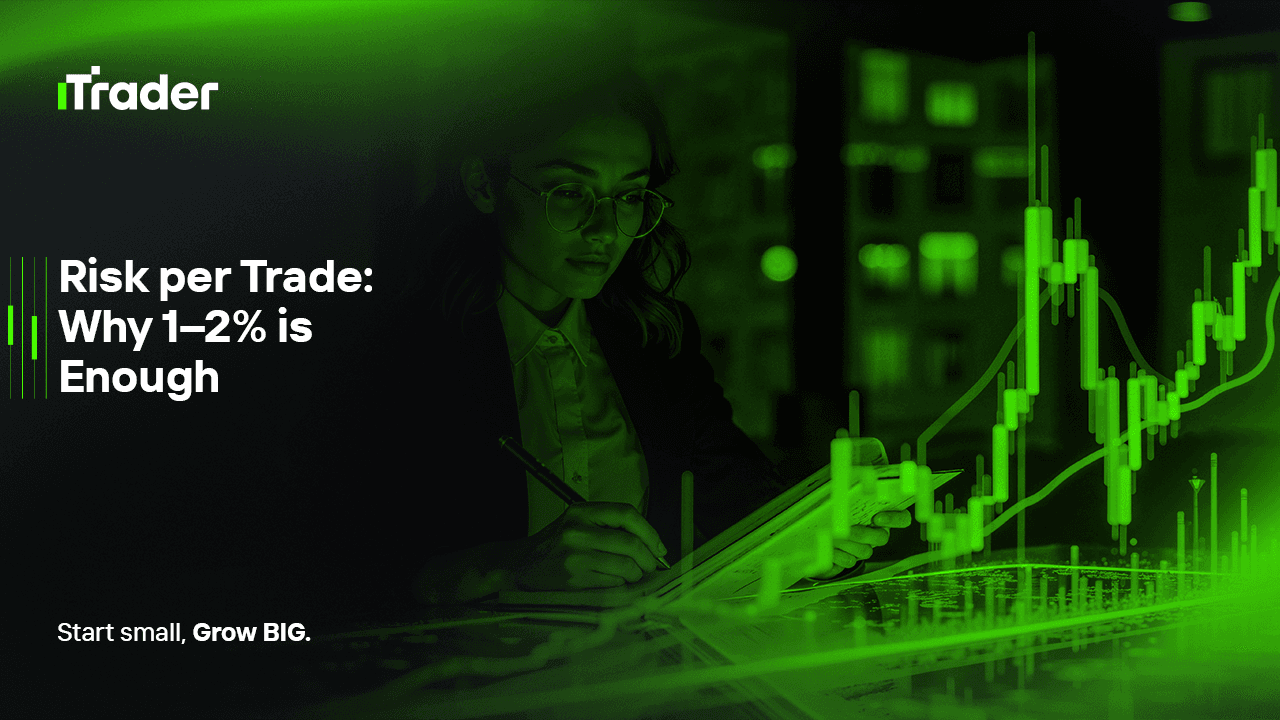2025-09-11
In forex trading, many traders focus on building profitable strategies, finding the best indicators, or identifying precise entry and exit points. Yet, the single most critical factor behind long-term success is risk management. The trader’s first goal is not to make money but to protect capital. This leads to the fundamental question: “How much of my account should I risk on a single trade?”

While there are many opinions, most professional traders and prop firm mentors agree on one golden rule: risking only 1–2% of your account per trade.
This blog will explain why that range has become the professional standard, backed by mathematics, psychology, and practical experience. We’ll also explore how this rule applies in the context of prop firm challenges, where strict drawdown rules demand disciplined risk control.
Risk per trade is the percentage of your trading account you are willing to lose if a trade goes against you.
For example:
This percentage determines not only your survival but also your ability to remain in a prop firm challenge, where strict daily and overall loss limits are enforced.
The 1–2% rule is based on statistical survival. It keeps losses small and recoverable.
As Warren Buffett famously said:
Preserving capital is the foundation of longevity in trading.
The probability of blowing an account (Risk of Ruin) grows exponentially when risk per trade increases. By keeping it within 1–2%, this probability becomes negligible, even through extended losing streaks.
Risking 5–10% per trade can quickly put an account into deep drawdown. Just a few losing trades may render recovery mathematically and psychologically impossible.
Large losses create fear and frustration, which disrupt discipline and often trigger impulsive decisions.
Traders who take oversized risks often try to “make it back quickly” with even larger positions. This is the fastest way to blow an account.
Prop firms like FTMO and MyForexFunds impose strict risk parameters:
If you risk 5% per trade, one bad trade could cause immediate failure. By keeping risk to 1–2%, you allow room for multiple trades and reduce the chance of disqualification.
Profitability is measured by expectancy:
Expectancy=(WinRate×AverageWin)–(LossRate×AverageLoss)Expectancy = (Win Rate × Average Win) – (Loss Rate × Average Loss)Expectancy=(WinRate×AverageWin)–(LossRate×AverageLoss)
With 1–2% risk, your losses remain small, and profitable trades can expand the account through favorable risk-to-reward ratios.
Keeping risk fixed at 1–2% allows for proper position sizing and consistent exposure, regardless of strategy or market volatility.
Let’s take a $100,000 prop firm challenge:
Clearly, the 1–2% approach provides far more breathing room.
The 1–2% rule is not just a guideline; it is a professional standard grounded in:
In trading, survival comes before profit. By keeping risk low, you buy yourself time for your edge to materialize. The 1–2% risk rule is the safest and most effective path to long-term consistency.
© 2025 iTrader Global Limited | 公司注册号 15962
iTrader Global Limited 位于科摩罗联盟安儒昂自治岛穆察姆杜 Hamchako,并受科摩罗证券委员会(Securities Commission of the Comoros)许可及监管。我们的牌照号为 L15962/ITGL。
iTrader Global Limited 以“iTrader”作为交易名称,获授权从事外汇交易业务。公司的标志、商标及网站均为 iTrader Global Limited 的专属财产。
风险提示: 差价合约(CFD)交易因杠杆作用存在高风险,可能导致资金快速亏损,并非适合所有投资者。
交易资金、差价合约及其他高杠杆产品需要具备专业知识。
研究显示,84.01% 使用杠杆的交易者会遭受亏损。请务必充分了解相关风险,并确认在交易前已做好承担资金损失的准备。
iTrader 特此声明,不会对任何个人或法人在杠杆交易中产生的风险、亏损或其他损失承担全部责任。
本网站提供的新闻及信息仅用于教育目的。用户应独立且审慎地作出金融决策。
限制条款: iTrader 不会向法律、法规或政策禁止此类活动的国家或地区居民提供本网站或相关服务。若您居住在限制使用本网站或服务的司法管辖区,您有责任确保遵守当地法律。iTrader 不保证其网站内容在所有司法管辖区均适用或合法。
iTrader Global Limited 不向以下国家/地区的公民提供服务,包括但不限于:美国、巴西、加拿大、以色列及伊朗。